Experimental Study on the Unsteady Natural Cloud Cavities: Influence of Cavitation Number on Cavity Evolution and Pressure Pulsations
Abstract
1. Introduction
2. Experimental Setup
3. Results and Discussion
3.1. The Evolution Patterns of Cloud Cavitating Flows
3.2. The Effects of Cavitation Number on Cavitation Evolution and Pressure Fluctuation
3.3. Influence of Cavitation Number on Frequency Characteristics of Cavitating Flows
4. Conclusions
Author Contributions
Funding
Conflicts of Interest
References
- Long, X.; Cheng, H.; Ji, B.; Arndt, R.E.; Peng, X. Large eddy simulation and Euler–Lagrangian coupling investigation of the transient cavitating turbulent flow around a twisted hydrofoil. Int. J. Multiph. Flow 2018, 100, 41–56. [Google Scholar] [CrossRef]
- Wittekind, D.; Schuster, M. Propeller cavitation noise and background noise in the sea. Ocean. Eng. 2016, 120, 116–121. [Google Scholar] [CrossRef]
- Ilieva, G.; Pirovsky, C. Modelling of Cavitation around Hydrofoils with Included Bubble Dynamics and Phase Changes. In Engineering Design Applications II; Springer: Berlin/Heidelberg, Germany, 2020; pp. 187–200. [Google Scholar]
- Ausoni, P.; Farhat, M.; Escaler, X.; Egusquiza, E.; Avellan, F. Cavitation influence on von Karman vortex shedding and induced hydrofoil vibrations. J. Fluids Eng. 2007, 129, 966–973. [Google Scholar] [CrossRef]
- Liu, M.; Tan, L.; Liu, Y.; Xu, Y.; Cao, S. Large eddy simulation of cavitation vortex interaction and pressure fluctuation around hydrofoil ALE 15. Ocean. Eng. 2018, 163, 264–274. [Google Scholar] [CrossRef]
- Wu, Q.; Huang, B.; Wang, G.; Cao, S. The transient characteristics of cloud cavitating flow over a flexible hydrofoil. Int. J. Multiph. Flow 2018, 99, 162–173. [Google Scholar] [CrossRef]
- Wu, Q.; Wang, C.C.; Huang, B.; Wang, G.Y.; Cao, S.L. Measurement and prediction of cavitating flow-induced vibrations. J. Hydrodyn. B 2018, 30, 1064–1071. [Google Scholar] [CrossRef]
- Ma, X.; Huang, B.; Zhao, X.; Wang, Y.; Chang, Q.; Qiu, S.; Wang, G. Comparisons of spark-charge bubble dynamics near the elastic and rigid boundaries. Ultrason. Sonochem 2018, 43, 80–90. [Google Scholar] [CrossRef]
- Knapp, R.T. Recent investigations of the mechanics of cavitation and cavitation damage. J. Appl. Mech. 1955, 77, 1045–1054. [Google Scholar]
- Dular, M.; Bachert, R.; Stoffel, B.; Širok, B. Experimental evaluation of numerical simulation of cavitating flow around hydrofoil. Eur. J. Mech. B Fluids 2005, 24, 522–538. [Google Scholar] [CrossRef]
- Chang, N.A.; Choi, J.; Yakushiji, R.; Ceccio, S.L. Cavitation inception during the interaction of a pair of counter-rotating vortices. Phys. Fluids 2012, 24, 014107. [Google Scholar] [CrossRef]
- Kinzel, M.P.; Krane, M.H.; Kirschner, I.N.; Moeny, M.J. A numerical assessment of the interaction of a supercavitating flow with a gas jet. Ocean. Eng. 2017, 136, 304–313. [Google Scholar] [CrossRef]
- Knapp, R.T.; Hollander, A. Laboratory investigations of the mechanism of cavitation. J. Appl. Mech. 1948, 70, 419–433. [Google Scholar]
- Rouse, H.; McNown, J.S. Cavitation and Pressure Distribution: Head Forms at Zero Angle of Yaw; The State University of Iowa: Ames, IA, USA, 1948. [Google Scholar]
- Logvinovich, G.V. Hydrodynamics of Flows with Free Boundaries; Naukova Dumka: Kiev, Ukraine, 1969; p. 16. [Google Scholar]
- Callenaere, M.; Franc, J.P.; Michel, J.M.; Riondet, M. The cavitation instability induced by the development of a re-entrant jet. J. Fluid Mech. 2001, 444, 223–256. [Google Scholar] [CrossRef]
- Wang, Z.; Huang, B.; Wang, G.; Zhang, M.; Wang, F. Experimental and numerical investigation of ventilated cavitating flow with special emphasis on gas leakage behavior and re-entrant jet dynamics. Ocean. Eng. 2015, 108, 191–201. [Google Scholar] [CrossRef]
- Shao, S.; Wu, Y.; Haynes, J.; Arndt, R.E.; Hong, J. Investigation into the behaviors of ventilated supercavities in unsteady flow. Phys. Fluids 2018, 30, 052102. [Google Scholar] [CrossRef]
- Wienken, W.; Stiller, J.; Keller, A. A method to predict cavitation inception using large-eddy simulation and its application to the flow past a square cylinder. J. Fluids Eng. 2006, 128, 316–3252006. [Google Scholar] [CrossRef]
- Sato, K.; Taguchi, Y.; Hayashi, S. High speed observation of periodic cavity behavior in a convergent-divergent nozzle for cavitating water jet. J. Flow Control Meas. Vis. 2013, 1, 102–107. [Google Scholar] [CrossRef]
- Wang, G.; Kong, D.; Wu, Q.; Liu, T.; Zheng, Y.; Huang, B. Physical and numerical study on unsteady shedding behaviors of ventilated partial cavitating flow around an axisymmetric body. Ocean. Eng. 2020, 197, 106884. [Google Scholar] [CrossRef]
- Kubota, A.; Kato, H.; Yamaguchi, H.; Maeda, M. Unsteady structure measurement of cloud cavitation on a foil section using conditional sampling technique. J. Fluids Eng. 1989, 111, 204–210. [Google Scholar] [CrossRef]
- Huang, B.; Young, Y.L.; Wang, G.; Shyy, W. Combined experimental and computational investigation of unsteady structure of sheet/cloud cavitation. J. Fluids Eng. 2013, 135, 071301. [Google Scholar] [CrossRef]
- Hu, C.L.; Wang, G.Y.; Huang, B.; Zhao, Y. The inception cavitating flows over an axisymmetric body with a blunt headform. J. Hydrodyn. B 2015, 27, 359–366. [Google Scholar] [CrossRef]
- Sun, T.; Zhang, X.; Xu, C.; Zhang, G.; Wang, C.; Zong, Z. Experimental investigation on the cavity evolution and dynamics with special emphasis on the development stage of ventilated partial cavitating flow. Ocean. Eng. 2019, 187, 106140. [Google Scholar] [CrossRef]
- Arndt, R.E.A. Cavitation in fluid machinery and hydraulic structures. Annu. Rev. Fluid Mech. 1981, 13, 273–328. [Google Scholar] [CrossRef]
- Arndt, R.E.A. Cavitation in vortical flows. Annu. Rev. Fluid Mech. 2002, 34, 143–175. [Google Scholar] [CrossRef]
- Le, Q.; Franc, J.P.; Michel, J.M. Partial cavities: Global behavior and mean pressure distribution. J. Fluids Eng. 1993, 115, 243–248. [Google Scholar] [CrossRef]
- Reisman, G.E.; Wang, Y.C.; Brennen, C.E. Observations of shock waves in cloud cavitation. J. Fluid Mech. 1998, 355, 255–283. [Google Scholar] [CrossRef]
- Pham, T.M.; Larrarte, F.; Fruman, D.H. Investigation of unsteady sheet cavitation and cloud cavitation mechanisms. J. Fluids Eng. 1999, 121, 289–296. [Google Scholar] [CrossRef]
- Wang, G.; Senocak, I.; Shyy, W.; Ikohagi, T.; Cao, S. Dynamics of attached turbulent cavitating flows. Prog. Aerosp. Sci. 2001, 37, 551–581. [Google Scholar] [CrossRef]
- Zhang, X.; Wang, C.; Wei, Y.; Sun, T. Experimental investigation of unsteady characteristics of ventilated cavitation flow around an under-water vehicle. Adv. Mech. Eng. 2016, 8. [Google Scholar] [CrossRef]
- Kawanami, Y.; Kato, H.; Yamaguchi, H.; Tanimura, M.; Tagaya, Y. Mechanism and control of cloud cavitation. J. Fluids Eng. 1997, 119, 788–794. [Google Scholar] [CrossRef]
- Astolfi, J.A.; Dorange, P.; Billard, J.Y.; Tomas, I.C. An experimental investigation of cavitation inception and development on a two-dimensional Eppler hydrofoil. J. Fluids Eng. 2000, 122, 164–173. [Google Scholar] [CrossRef]
- Zhang, X.; Wang, C.; Wekesa, D.W. Numerical and experimental study of pressure-wave formation around an underwater ventilated vehicle. Eur. J. Mech. B Fluids 2017, 65, 440–449. [Google Scholar] [CrossRef]
- Wang, C.; Huang, B.; Wang, G.; Zhang, M.; Ding, N. Unsteady pressure fluctuation characteristics in the process of breakup and shedding of sheet/cloud cavitation. Int. J. Heat Mass Transf. 2017, 114, 769–785. [Google Scholar] [CrossRef]
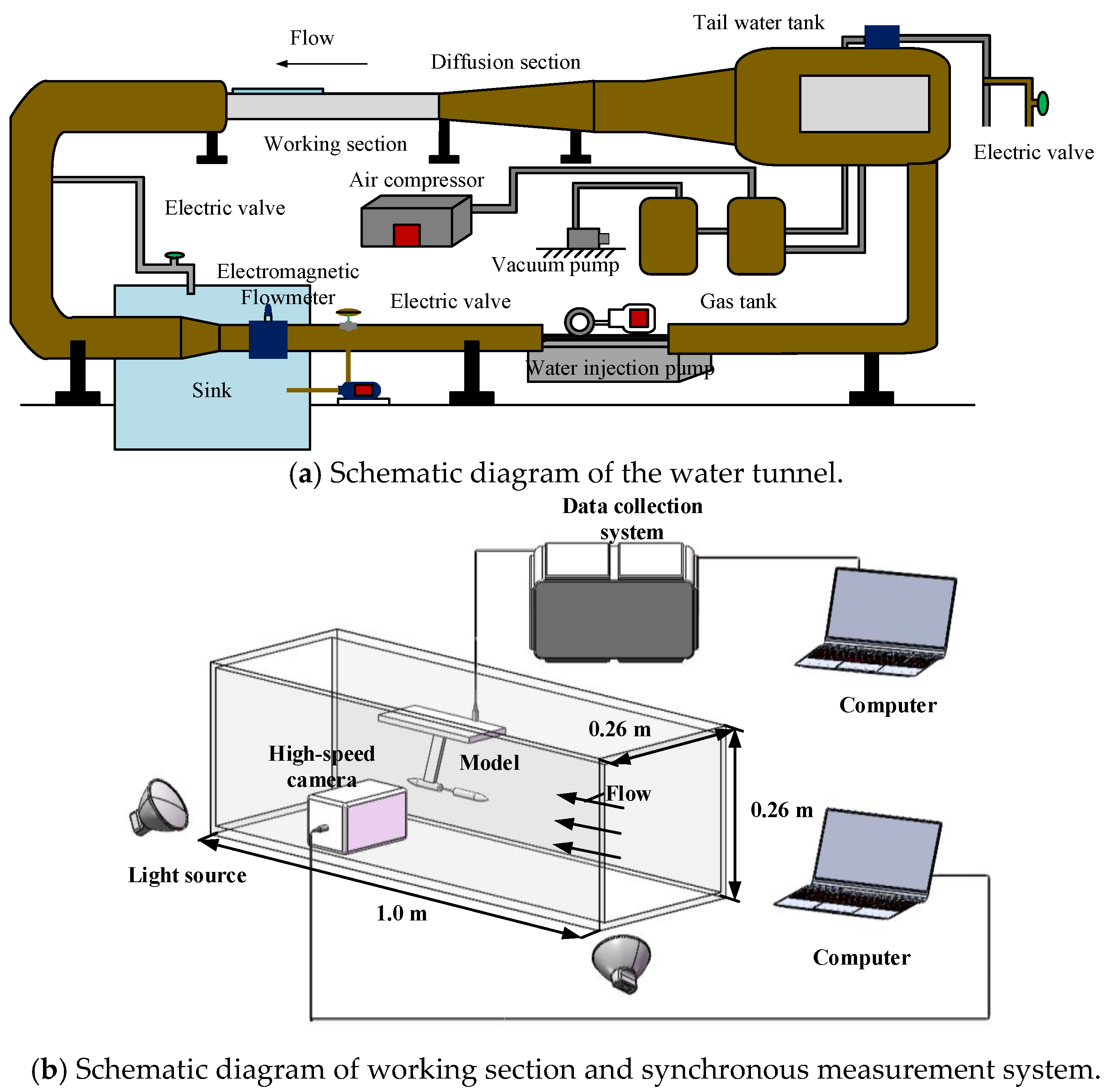

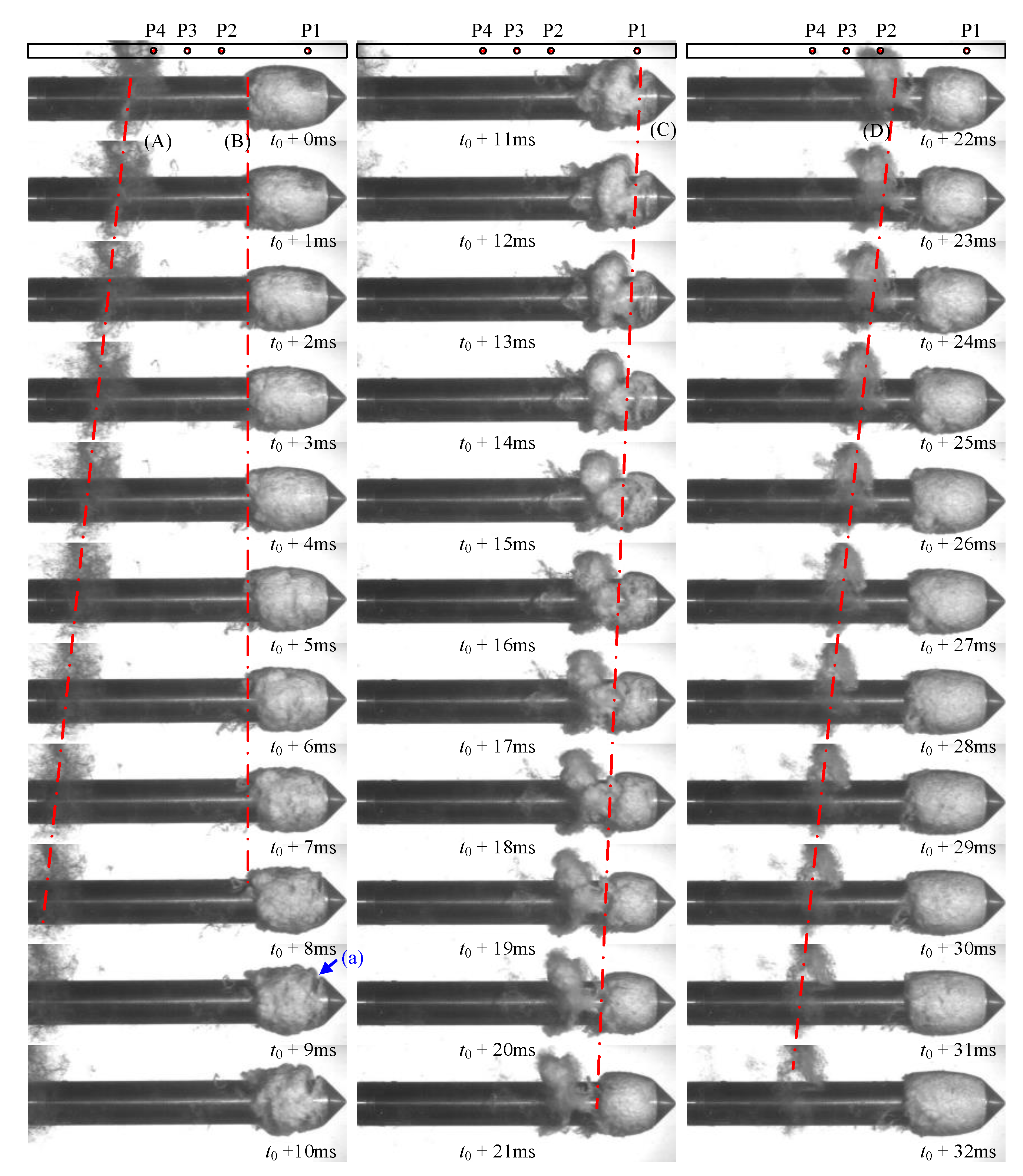
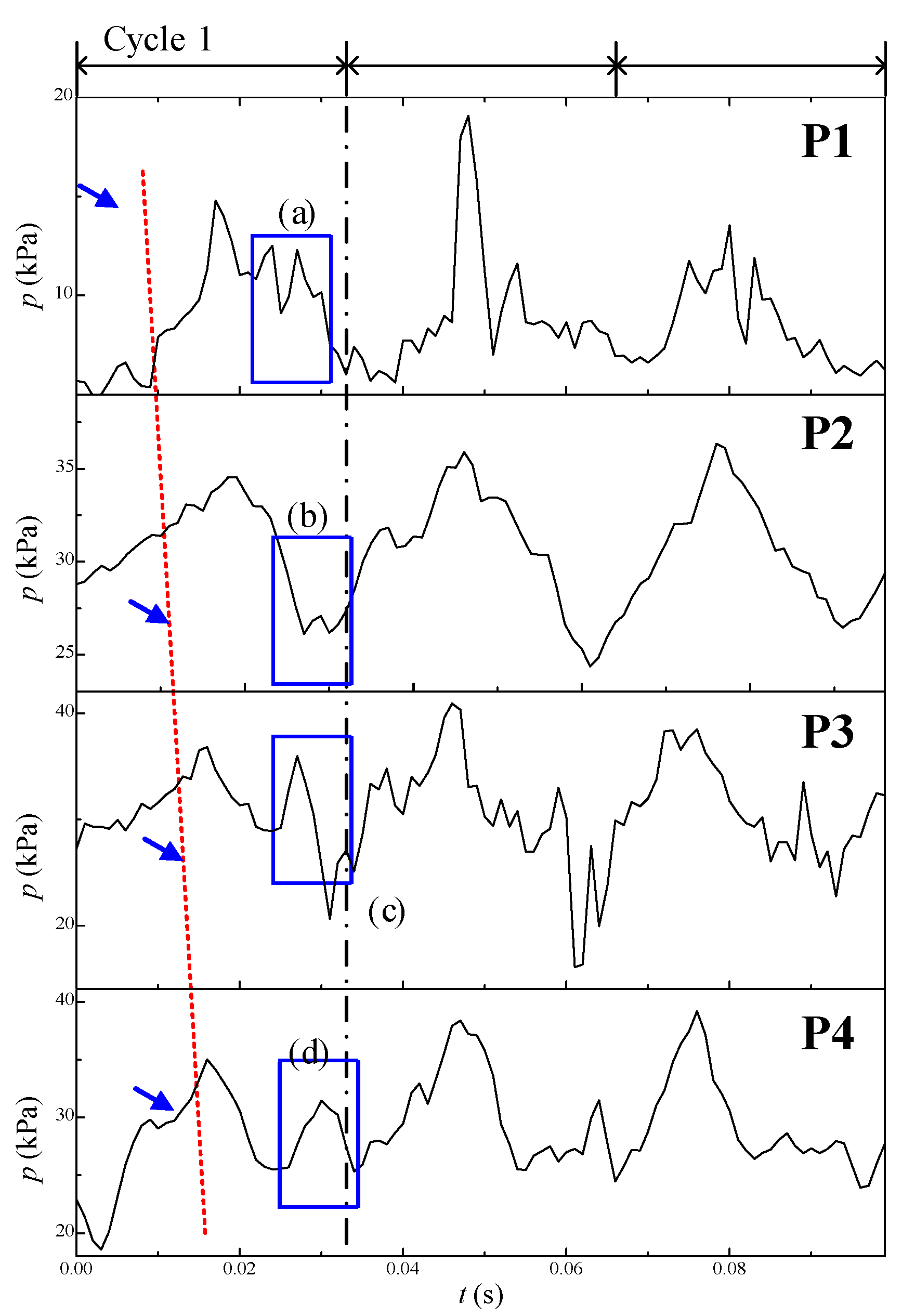
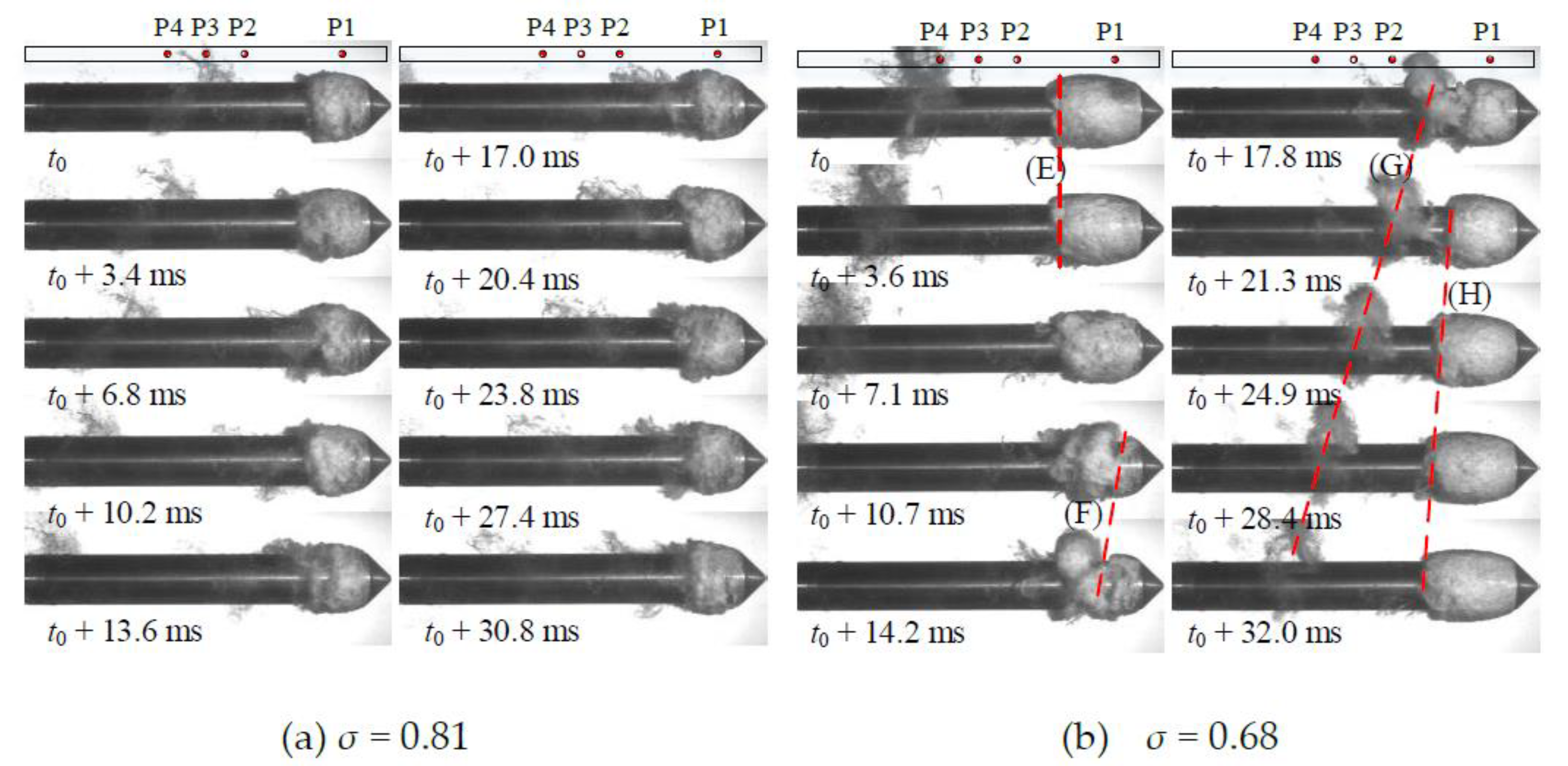
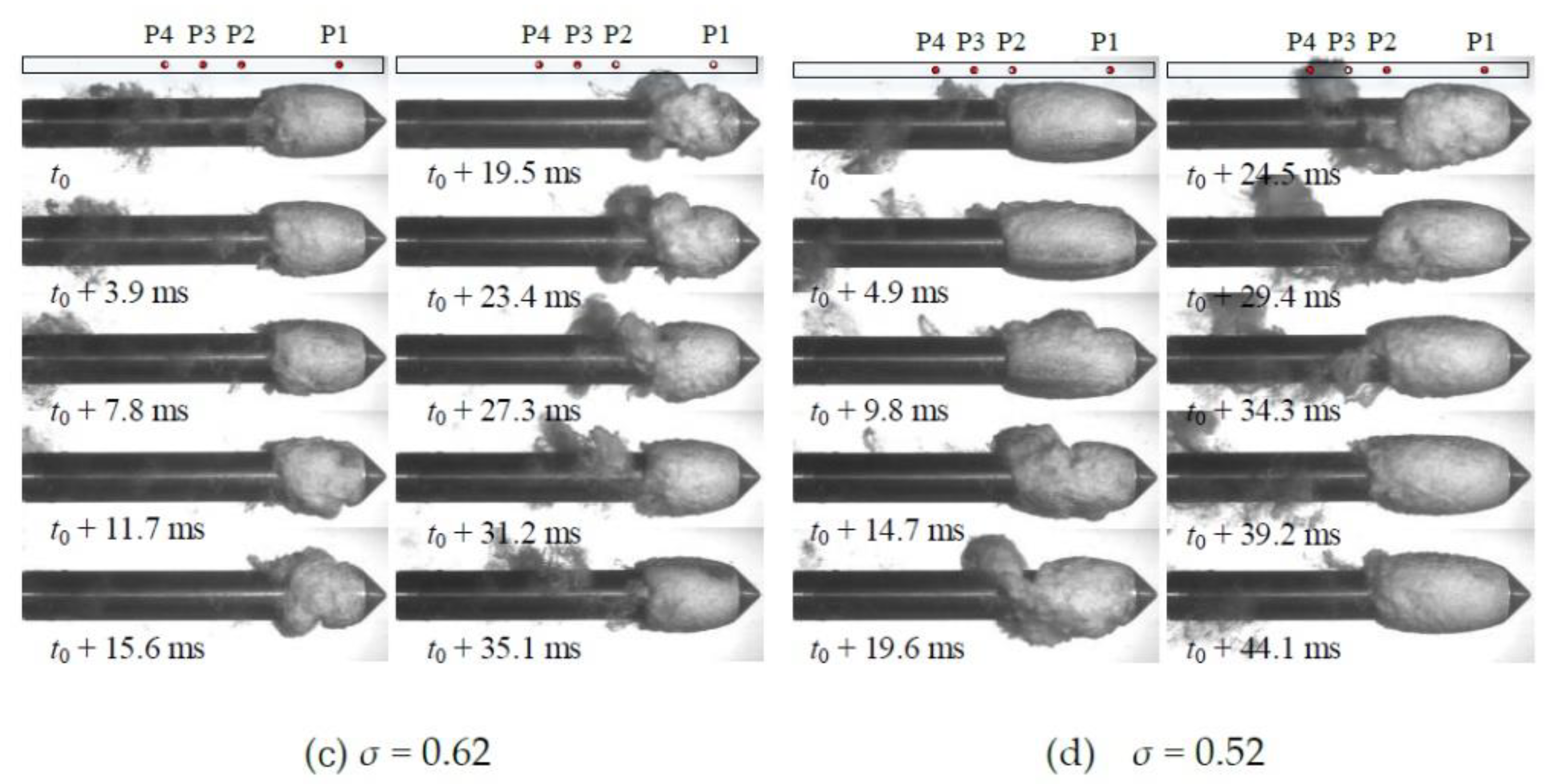
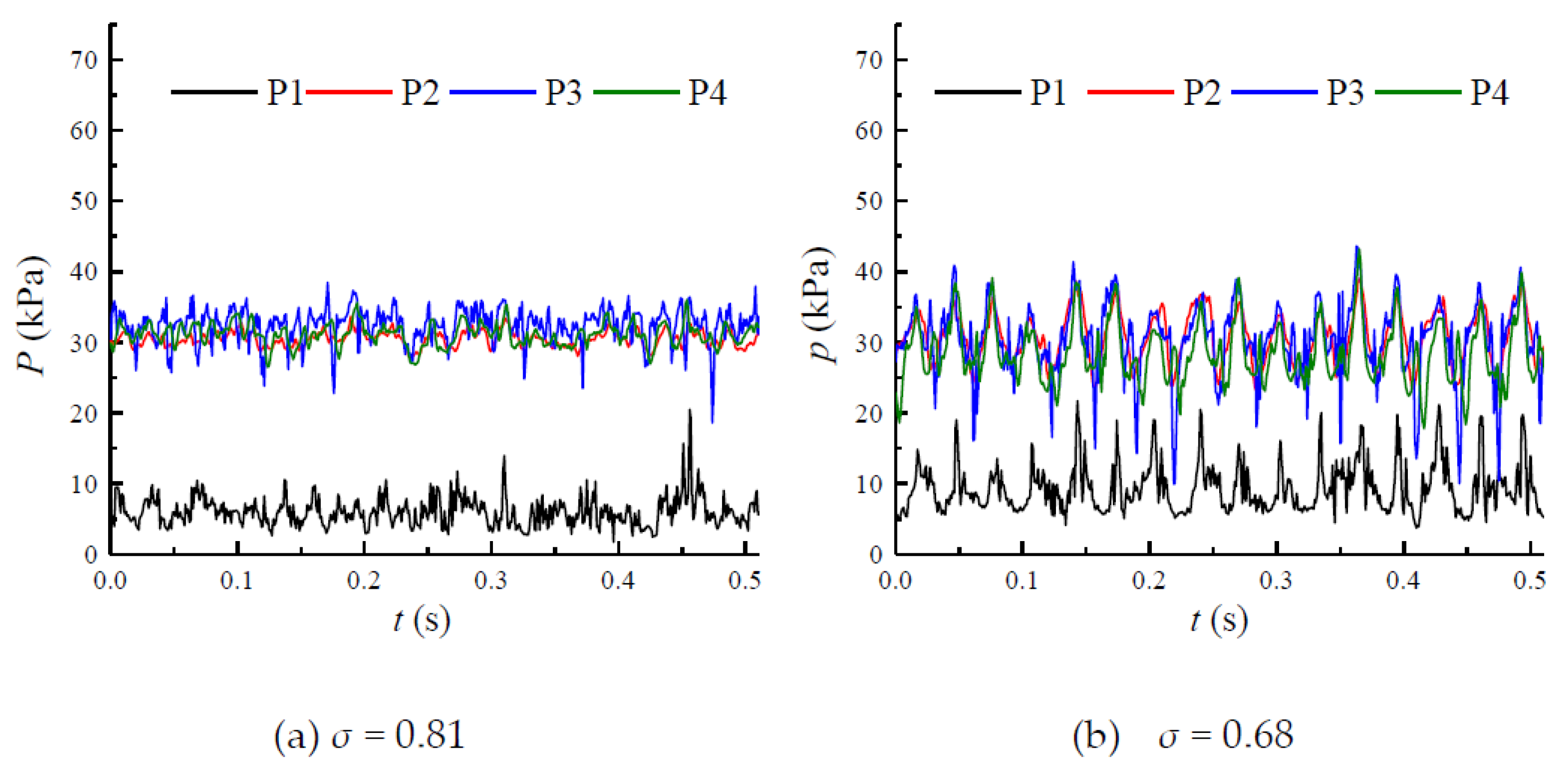
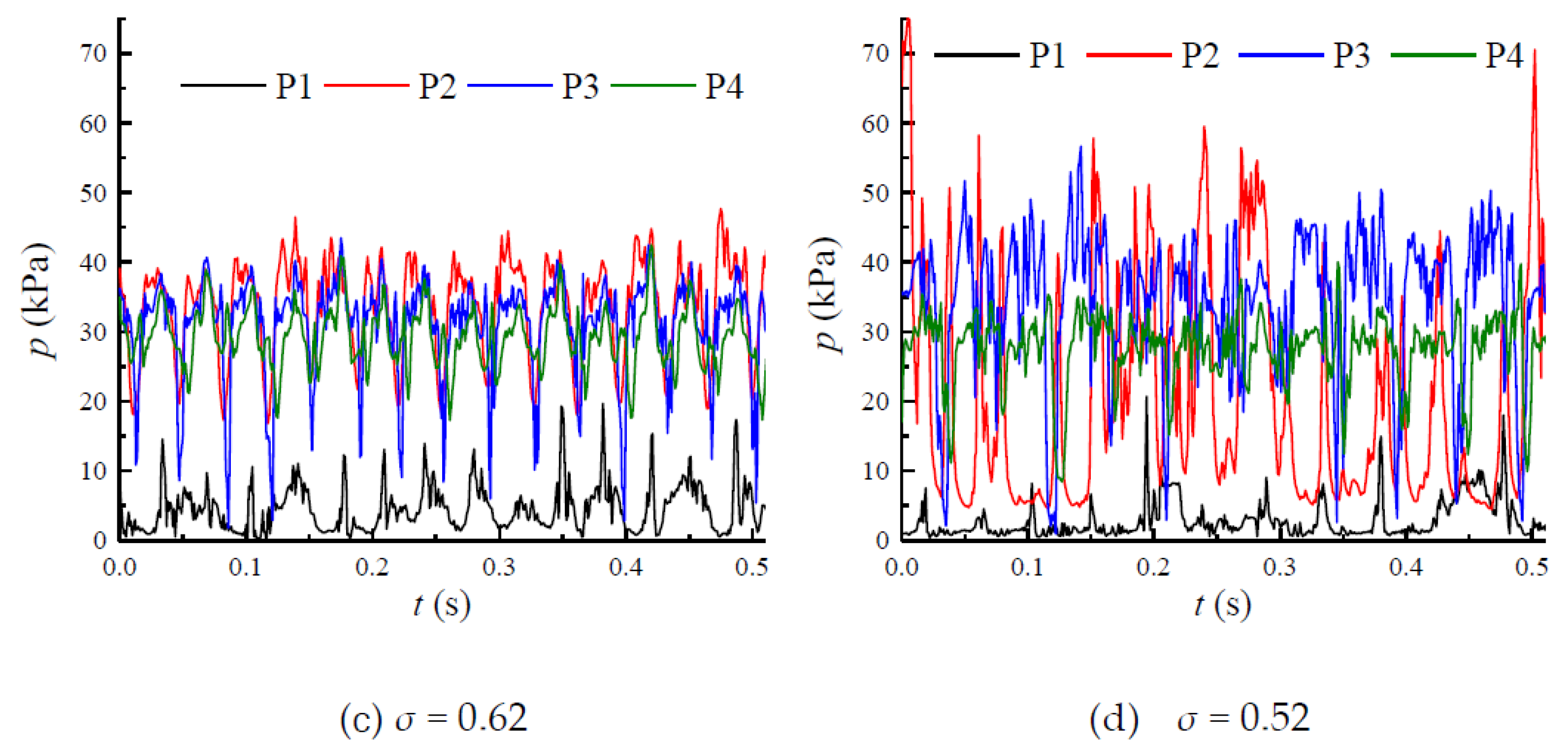
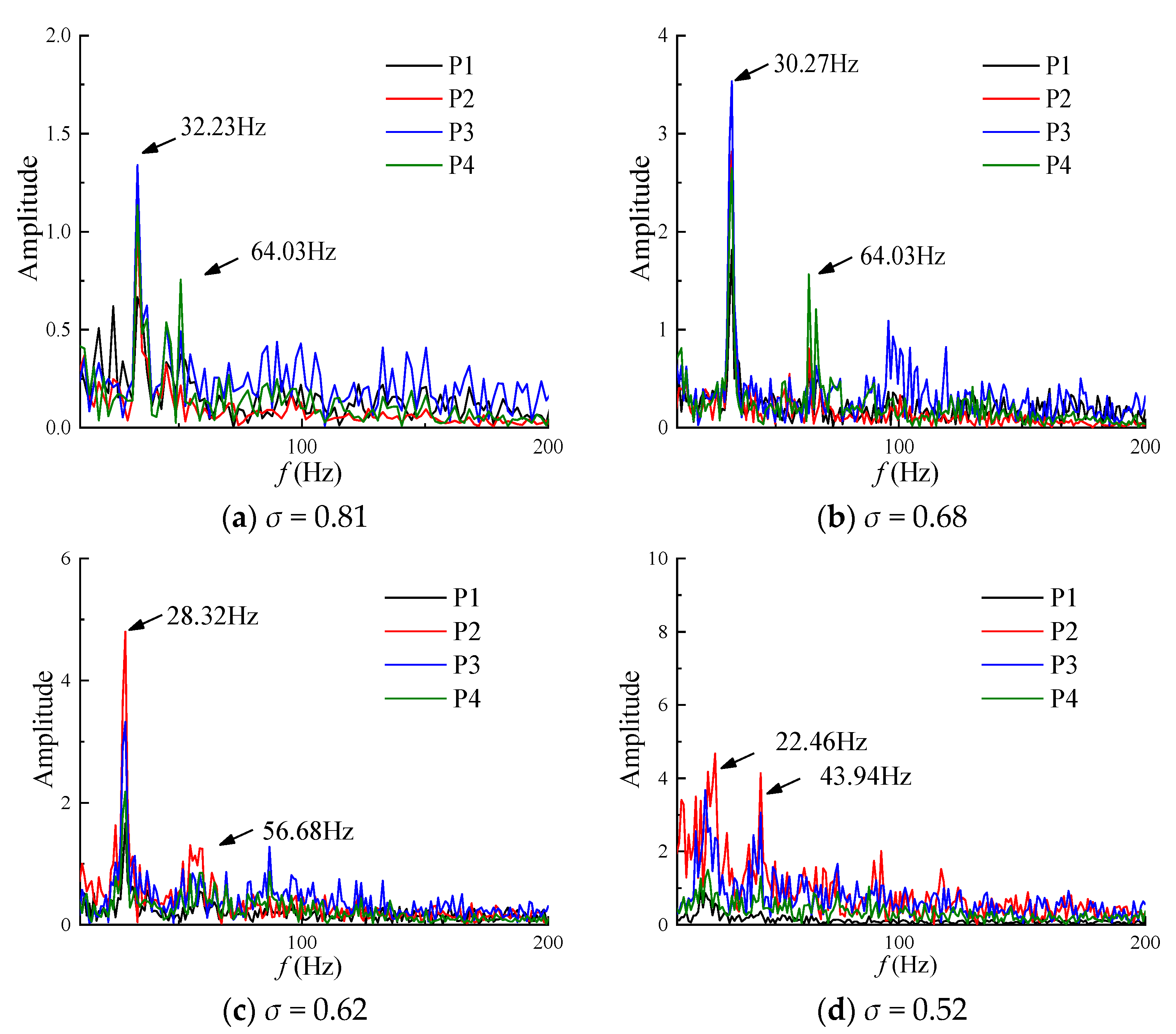
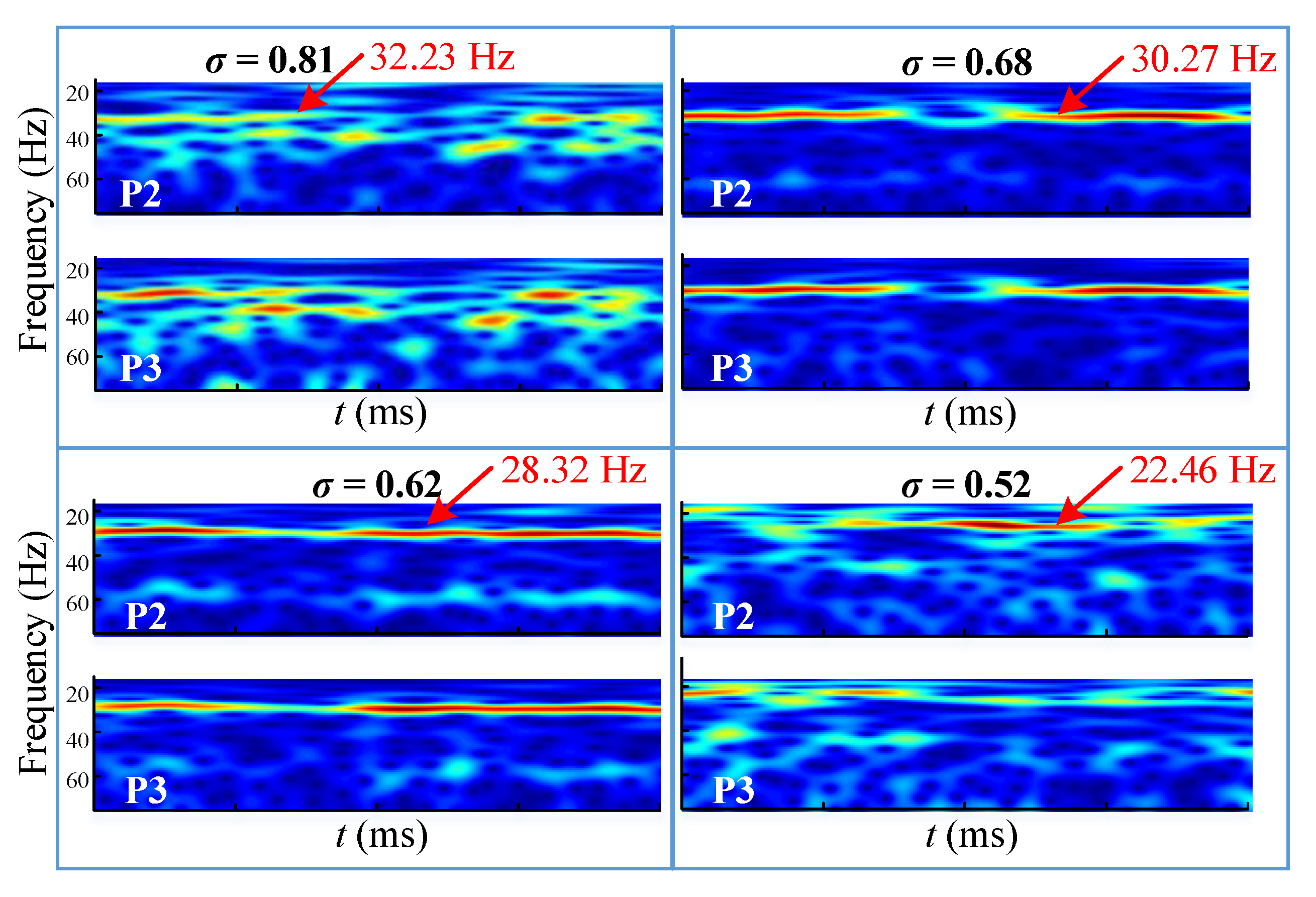
| Cavitation Number σ | Main Frequency f1 (Hz) | Secondary Frequency f2 (Hz) | Primary and Secondary Frequency Ratio f2/f1 |
|---|---|---|---|
| 0.81 | 32.23 | 51.43 | 1.6 |
| 0.68 | 30.27 | 64.03 | 2.1 |
| 0.62 | 28.32 | 56.68 | 2.0 |
| 0.52 | 22.46 | 43.94 | 2.0 |
Publisher’s Note: MDPI stays neutral with regard to jurisdictional claims in published maps and institutional affiliations. |
© 2021 by the authors. Licensee MDPI, Basel, Switzerland. This article is an open access article distributed under the terms and conditions of the Creative Commons Attribution (CC BY) license (https://creativecommons.org/licenses/by/4.0/).
Share and Cite
Sun, T.; Zhang, X.; Zhang, J.; Wang, C. Experimental Study on the Unsteady Natural Cloud Cavities: Influence of Cavitation Number on Cavity Evolution and Pressure Pulsations. J. Mar. Sci. Eng. 2021, 9, 487. https://doi.org/10.3390/jmse9050487
Sun T, Zhang X, Zhang J, Wang C. Experimental Study on the Unsteady Natural Cloud Cavities: Influence of Cavitation Number on Cavity Evolution and Pressure Pulsations. Journal of Marine Science and Engineering. 2021; 9(5):487. https://doi.org/10.3390/jmse9050487
Chicago/Turabian StyleSun, Tiezhi, Xiaoshi Zhang, Jianyu Zhang, and Cong Wang. 2021. "Experimental Study on the Unsteady Natural Cloud Cavities: Influence of Cavitation Number on Cavity Evolution and Pressure Pulsations" Journal of Marine Science and Engineering 9, no. 5: 487. https://doi.org/10.3390/jmse9050487
APA StyleSun, T., Zhang, X., Zhang, J., & Wang, C. (2021). Experimental Study on the Unsteady Natural Cloud Cavities: Influence of Cavitation Number on Cavity Evolution and Pressure Pulsations. Journal of Marine Science and Engineering, 9(5), 487. https://doi.org/10.3390/jmse9050487







